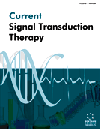- Home
- A-Z Publications
- Current Signal Transduction Therapy
- Previous Issues
- Volume 4, Issue 3, 2009
Current Signal Transduction Therapy - Volume 4, Issue 3, 2009
Volume 4, Issue 3, 2009
-
-
Cancer Invasion and Metastasis: Discovering New Targets For Diagnosis and Therapeutics
More LessAuthors: Riccardo Alessandro, Simona Fontana and Giacomo De LeoCancer invasion and metastases are the hallmarks of malignant tumors and the cause of most cancer deaths. Molecular alterations that arise during cancer progression and that generate abnormal gene products, activated signal transduction pathways, and altered cancer cell-host stroma interactions can be considered targets of therapeutic drugs. Some of these drugs have already entered clinical trials, while others have Read More
-
-
-
Hypoxia Inducible Factor-1 as a Therapeutic Target in Cerebral Ischemia
More LessCerebral ischemia is the third leading cause of death in industrialized countries and an important health system problem with no efficient treatment to date. The reduction in oxygen and glucose supply triggers a cascade of events such as excitotoxicity, oxidative stress, inflammation, apoptosis, and an adjustment of the gene expression program. The hypoxia inducible factor-1 (HIF-1) is a transcription factor that mediates the ad Read More
-
-
-
When BMP Signalling Goes Wrong: The Intracellular and Molecular Mechanisms of BMP Signalling in Cancer
More LessAuthors: Sivan M. Bokobza, Lin Ye and Wen Guo JiangBone Morphogenetic Proteins (BMPs), members of the TGF-β superfamily, are pleiotropic growth factors, known for their role in embryogenesis and bone induction. BMPs signal via two types of serine/threonine kinase BMP receptors (BMPRs), type I, and type II receptors. Ligand binding induces activation of the downstream signalling molecules, the SMADs, which regulate the expression of BMP-responsive genes including those i Read More
-
-
-
Paralysation of HIV Without Impairing Other Cells
More LessAuthors: Majid Vaezzadeh and Mohammadreza SaeidiSince recognition of HIV, many scientists in several branches have attempted to inactive it. Although different methods are available to destroy it, but these methods may damage vital cells too. This paper suggests a theoretical method to paralyze only HIV. The virus contains certain glycoprotein (gp120) which permits HIV to attach receptor host cell (CD4). Applying a sinusoidal electric field with a definite frequency m Read More
-
-
-
Targeting JAK/STAT Signaling Pathway in Inflammatory Diseases
More LessAuthors: Charles J. Malemud and Eric PearlmanIn immune-mediated chronic inflammation the balance between pro-inflammatory and anti-inflammatory cytokines is skewed so that elevated levels of circulating pro-inflammatory cytokines of the interleukin (IL), interferon (IFN) protein families and TNF-α is favored. Several of the pro-inflammatory IL-family cytokines, including most prominently, IL-6, IL-12, IL-17, IL-23, as well as IFN-γ, activate the Janus Kinase/Signal T Read More
-
-
-
The Inhibitory Effect of Cyclosporine A and Prednisolone on Both Cytotoxic CD8+ T Cells and CD4+CD25+ Regulatory T Cells
More LessThe immunosuppressive drugs Cyclosporine A (CSA) and prednisolone are widely used to prevent graftversus- host-disease (GVHD) after allogenetic stem cell transplantation (allo-SCT). However, it remains to be elucidated whether these drugs have an effect on the balance of effector cells and CD4+CD25+ regulatory T cells (Tregs) which determines the development of stable allograft tolerance. In the current study, w Read More
-
Volumes & issues
-
Volume 20 (2025)
-
Volume 19 (2024)
-
Volume 18 (2023)
-
Volume 17 (2022)
-
Volume 16 (2021)
-
Volume 15 (2020)
-
Volume 14 (2019)
-
Volume 13 (2018)
-
Volume 12 (2017)
-
Volume 11 (2016)
-
Volume 10 (2015)
-
Volume 9 (2014)
-
Volume 8 (2013)
-
Volume 7 (2012)
-
Volume 6 (2011)
-
Volume 5 (2010)
-
Volume 4 (2009)
-
Volume 3 (2008)
-
Volume 2 (2007)
-
Volume 1 (2006)
Most Read This Month
Article
content/journals/cst
Journal
10
5
false
en


